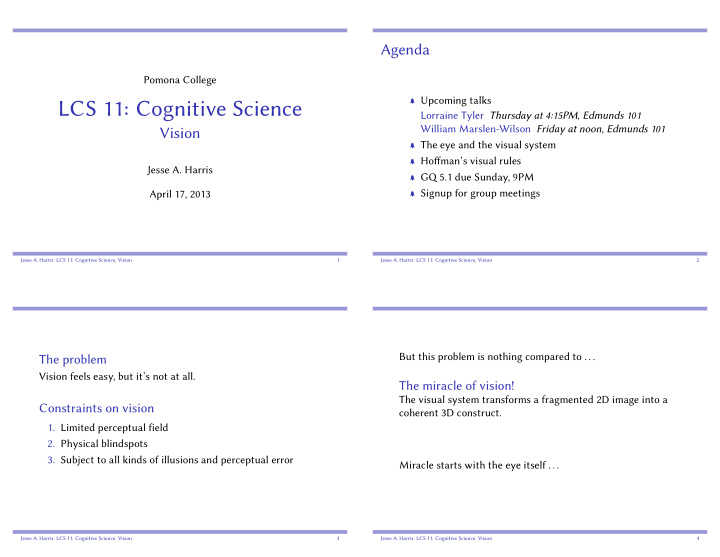



Agenda Pomona College ֠ Upcoming talks LCS 11: Cognitive Science Lorraine Tyler Thursday at 4:15PM, Edmunds 101 William Marslen-Wilson Friday at noon, Edmunds 101 Vision ֠ The eye and the visual system ֠ Ho ff man’s visual rules Jesse A. Harris ֠ GQ 5.1 due Sunday, 9PM ֠ Signup for group meetings April 17, 2013 Jesse A. Harris: LCS 11: Cognitive Science, Vision 1 Jesse A. Harris: LCS 11: Cognitive Science, Vision 2 But this problem is nothing compared to ... The problem Vision feels easy, but it’s not at all. The miracle of vision! The visual system transforms a fragmented 2D image into a Constraints on vision coherent 3D construct. 1. Limited perceptual fi eld 2. Physical blindspots 3. Subject to all kinds of illusions and perceptual error Miracle starts with the eye itself ... Jesse A. Harris: LCS 11: Cognitive Science, Vision 3 Jesse A. Harris: LCS 11: Cognitive Science, Vision 4
Visible eye Cornea Curved transparent lens through which light enters. Focuses light onto the retina. Light bent and slowed by cornea. Iris Provides an adjustable aperture (colored part of eye). Pupil Hole in middle of iris, adjusts for amount of light Smaller when more light, limiting the amount let through to another lens. Jesse A. Harris: LCS 11: Cognitive Science, Vision 5 Jesse A. Harris: LCS 11: Cognitive Science, Vision 6 Inner eye Lens Contracts to give give more refractive power, needed for focusing on close objects. Power to accommodate by contraction decreases with age. Retina Light sensitive layer lining back of eye, containing multiple types of photoreceptors (rods and cones) and a chain of cells that provide the fi rst, rough processing, ending in the retinal ganglion cells. Fovea Area with dense population of cones for acuity Jesse A. Harris: LCS 11: Cognitive Science, Vision 7 Jesse A. Harris: LCS 11: Cognitive Science, Vision 8
Age related decline Lens Contraction Lens contracts to focus image on fovea when images are close (a). Correction When the muscles cannot contract the lens enough (b), corrective lenses allow for adjustment (c). Jesse A. Harris: LCS 11: Cognitive Science, Vision 9 Image projection Image projection Psychologist G. M. Stratton wore lens over his eyes that inverted the images - to right side up. After about 8 days, adjusted well (but not entirely) to the inverted image. G. M. Stratton (1865–1957) Jesse A. Harris: LCS 11: Cognitive Science, Vision 12
Neural retina Neural retina LGN Retinotopic maps ◮ Light gathered from retina maintains its spatial features of its representation in other areas of the brain 1. Signals sent from retinal ganglion cells to lateral ◮ Simplistic representation of how information is relayed geniculate nucleus (LGN) from retina to the primary visual cortex Cells in LGN responsible for retinotopic mapping - 1. Light activates electrical impluses in retina arrangement of receptive fi eld according to an orderly 2. Carried via fi bers of the optic nerve to highly speci fi c map. areas in the lateral geniculate nucleus (LGN) 3. Transmitted to primary visual cortex (V1) in occipital region (back) of the brain Jesse A. Harris: LCS 11: Cognitive Science, Vision 15 Jesse A. Harris: LCS 11: Cognitive Science, Vision 16
Stereopsis Random dot stereogram Stereopsis The perception of depth that occurs with normal, binocular vision. ◮ Slightly di ff erent visual inputs to each eye due to di ff erent locations ◮ Gives rise to depth perception ◮ Also to 3D movies ◮ 10% of population do not perceive depth in 3D movies, often due to damage to eye during development Jesse A. Harris: LCS 11: Cognitive Science, Vision 17 Jesse A. Harris: LCS 11: Cognitive Science, Vision 18 Random dot stereogram Primary visual area After basic processing, signals sent to V1 for visual processing Selectivity Cells in V1 tuned to respond to very selective features ◮ orientation ◮ edges ◮ light Classical Hubel & Wiesel demonstration of selectivity in V1: http://www.youtube.com/watch?v=IOHayh06LJ4 Jesse A. Harris: LCS 11: Cognitive Science, Vision 19 Jesse A. Harris: LCS 11: Cognitive Science, Vision 20
Fundamental problem of vision The image at the eye has countless possible interpretations. ◮ Visual input can matched up in any number of ways with the world ◮ Visual system applies rules and defaults to transform ambiguous or indeterminate cues into a coherent percept (mental construction what is perceived). Jesse A. Harris: LCS 11: Cognitive Science, Vision 21 Rotated tables http://www.michaelbach.de/ot/sze_shepardTables/Q Jesse A. Harris: LCS 11: Cognitive Science, Vision 24
Construction of percept Rules Rule of generic view Construct only those visual worlds for which the image is stable (i.e., generic) view. The fundamental role of visual rules You construct visual worlds from ambiguous images in Rule 1 conformance to visual rules. Constants in construction implies Always interpret a straight line in an image as a straight line constants among visual interpretation - rules. in 3D. Jesse A. Harris: LCS 11: Cognitive Science, Vision 25 Jesse A. Harris: LCS 11: Cognitive Science, Vision 26 Rules Rules Rule of generic view Rule of generic view Construct only those visual worlds for which the image is Construct only those visual worlds for which the image is stable (i.e., generic) view. stable (i.e., generic) view. Rule 2 Rule 2 If the tips of two lines coincide in an image, then always If the tips of two lines coincide in an image, then always interpret them as coinciding in 3D. interpret them as coinciding in 3D. Jesse A. Harris: LCS 11: Cognitive Science, Vision 27 Jesse A. Harris: LCS 11: Cognitive Science, Vision 28
Penrose triangle Penrose triangle East Perth, Australia Jesse A. Harris: LCS 11: Cognitive Science, Vision 29 Jesse A. Harris: LCS 11: Cognitive Science, Vision 30 Kopfermann fi gure Rules 1 and 2 allow us to prune many possible interpretations Jesse A. Harris: LCS 11: Cognitive Science, Vision 31
Recommend
More recommend